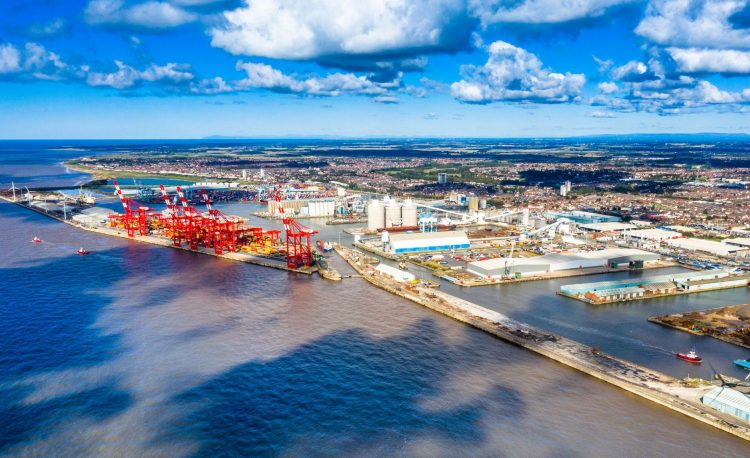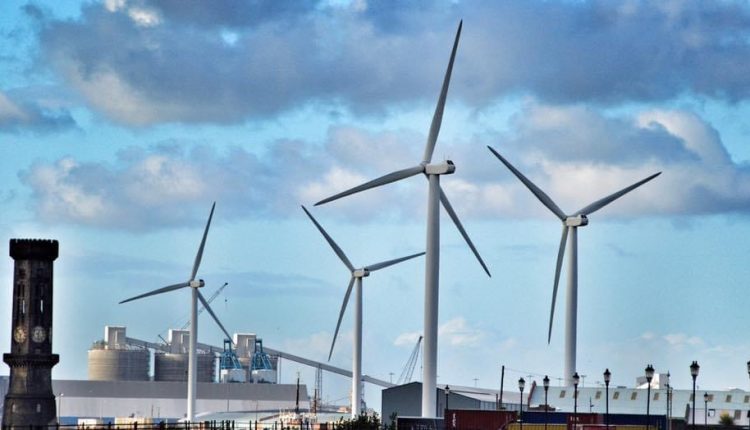Peel Ports plans bigger turbines for Port of Liverpool
Peel Ports partners with energy giant E.ON in a plan to install new wind turbines at the Port of Liverpool, increasing generating capacity by 373%. Andrew Brown reports

New wind turbines could be installed at the Port of Liverpool – more than twice the height of the existing structures.
These new turbines would see a 373% increase in capacity, with two fewer structures than originally allowed back in the 1990s, though larger in scale.
E.ON UK Heat and Peel Ports has submitted a screening opinion for the repowering of the Royal Seaforth Dock wind turbines at Maritime Centre, Bootle.
The tip height of the new turbines would grow from 75 metres to 180 metres if permission is granted by Sefton Council.
Tip height of the new turbines would be 180 metres; the hub height would be 111m; the rotor diameter would be 138m; the turbine output would be 4.26MW per turbine; the Windfarm Generation Capacity would be 17.04MW in total.
The original consented layout of six V44 turbines offered an overall output of 3.6MW. Repowering the windfarm with four modern turbines would allow for a 373% increase in output, with two fewer structures, though larger in scale.
An application submitted by Cogeo on behalf of E.ON UK Heat to Sefton Council says: “This report seeks a screening opinion from Sefton Council for the repowering of the Royal Seaforth Dock wind turbines at Maritime Centre, Bootle
“The existing linear array windfarm development consists of five Vestas V44 wind turbines, measuring 75m to blade tip alongside associated infrastructure positioned on the dock’s edge bounding the River Mersey.
“Consented and constructed in 1999 with originally six turbines, the five remaining machines have successfully operated at the dockside for 24 years.
“Current proposals seek the repowering of the Royal Seaforth Dock windfarm to upgrade the wind turbines to newer, more efficient and modern machines.
“Given onsite energy demand and advances in wind turbine technology, the repowering proposal will involve the lowering of the existing five turbines and erection of four Enercon E138 turbines in replacement.”
The application added: “Operating 24 hours, 7 days a week, the dock is an ever-changing and evolving landscape with significantly high energy demand for ongoing processes.
“With existing wind energy technology at the docks, E.ON were approached to engage on the potential repowering of the windfarm to meet current demand.
“Following vast expansion and modernisation since the initial construction of the windfarm, onsite demand has increased. During which time, wind energy technologies have also vastly improved with larger machinery offering much higher generation output.
“At the time of installation, the Vestas V44 turbines erected would likely have been the largest typology available at 600kW per machine.
“By repowering the windfarm, erecting four Enercon E138 models, the overall generation capacity of the site would increase to 17.04MW; significantly more than the original 3.6MW output.

“Through site investigations and engagement with turbine manufacturers, it is proposed that the existing windfarm is lowered, with the repowering allowing the continued generation of onshore wind energy at the dock.”
The current operational five turbines would be lowered and removed from the site, with four new turbines erected in replacement.
READ MORE: New sea link bringing tomatoes to Liverpool
READ MORE: Peel Ports reports revenues close to £700m
As is required with repowering, the footings of the existing turbines cannot be repurposed, and as such, new foundations would be installed.
To minimise the overall impact, the repowered structures would be positioned in close proximity to those being decommissioned.
In addition to the wind turbines, the development would require associated electrical infrastructure, including a meter house at the base of each turbine and one substation unit onsite.

